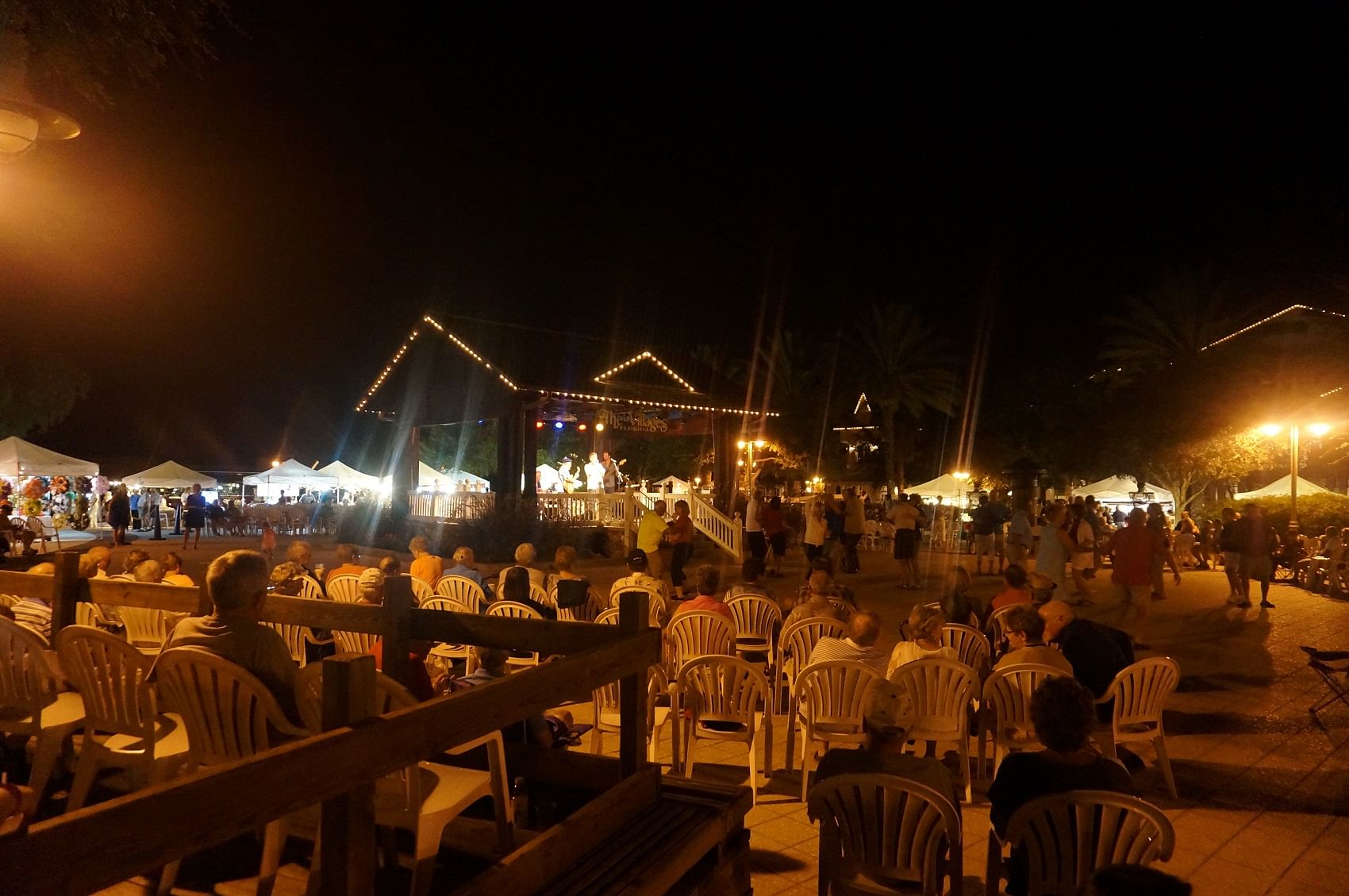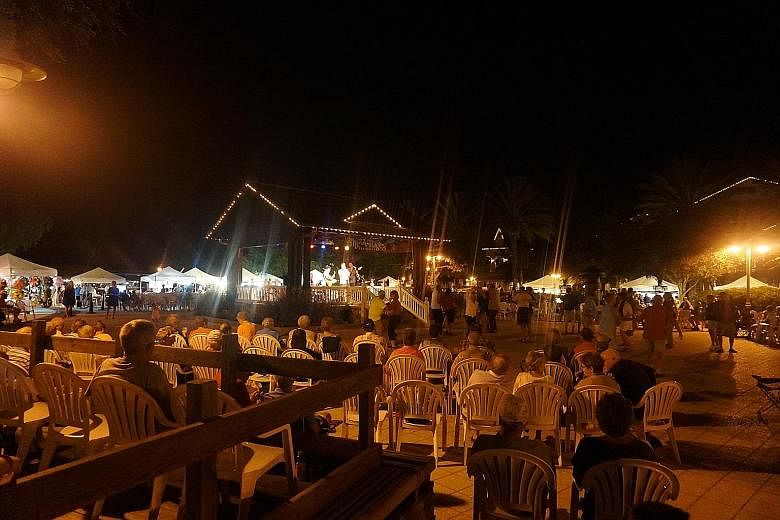WASHINGTON • For two consecutive years, the fastest- growing metro area in the United States was not a buzzing city like New York or San Francisco.
Instead, it was a picturesque golf-cart driving, social-dancing active retirement community in central Florida called The Villages - signalling a shift in US demographics.
On a Thursday night, the town square is filled with seniors drinking beer and dancing to a blues band. Here, residents say property that goes on the market is snapped up within days because of the huge demand from those 55 years and older who qualify to live here.
Said resident Kathy Anderson, 73: "There are bulletins that come out every week and there are hundreds of activities for us."


The 110,000-strong community offers a glimpse into the lives of older Americans, who are working longer, staying active and willing to spend on social activities, healthcare, property and technology.
They generate what is known in the US as the longevity economy - the sum of all economic activity serving the needs of Americans over 50 - a term coined by thought leaders at the AARP, formerly the American Association of Retired Persons.
As a group, the over 50s are some of the most significant contributors to the economy, responsible for at least US$7.1 trillion (S$10 trillion) - 46 per cent of US GDP - in annual economic activity in 2012. Such a sum, when compared to national economies, would be placed behind the US and China.
By 2032, this longevity economy is projected to make up about 52 per cent of US GDP, according to a report commissioned by the AARP.
Says Mr Jody Holtzman, AARP's senior vice-president in thought leadership: "Many of the conversations about the future of the US economy have a strong thread that - when you peel away the niceties - say we can't afford all these old people, but really the economy can't afford not to have them."
The AARP study also shows older Americans plan to remain in the workforce for longer, start second careers and work after retirement. In fact, those in their 50s and 60s start businesses at nearly twice the rate of people in their 20s, it added.
They also bolster the economy in other ways.
Ms Sue Peschin, president and chief executive of the non-profit Alliance for Ageing Research (AAR), says: "Many contribute through volunteer work, and also through caregiving for their grandchildren while their kids work."
So instead of being a financial burden, seniors are called a net national asset as they continue to contribute to the economy in varied ways, taking America in new directions.
By 2030, 20 per cent of Americans are projected to be 65 and over, according to the US Census Bureau, compared with about 14.5 per cent last year.
As their numbers rise, older Americans are driving the growth of the healthcare industry with their desire to lead active lives and age in place.
Toys for seniors
The Agelab at the Massachusetts Institute of Technology and the Oregon Centre for Ageing and Technology (Orcatech) at the Oregon Health and Science University (OHSU) are just two of the many groups looking into how to better care for elders and tailor innovation to their needs.
The non-profit AAR believes research into the ageing process is a matter of national interest.
"By extending a person's healthy years by two years, we could save over US$7 trillion over the next 50 years," says Ms Peschin.
She adds that currently only US$1.2 billion, of the US$32 billion that goes to the National Institute of Health for medical research, is used for ageing research.
At Orcatech, an ongoing study uses sensors to assess motor activity and speed of movement of seniors in their homes.
Currently, about 130 homes in the greater Portland area are wired up with motion and contact sensors that collect data on participants' movements, including when they pick up the telephone or open the front door.
One report by the group showed that when seniors are categorised into fast-, medium- and slow-walking speed groups, those with mild cognitive impairment, such as memory problems, are eight times more likely to come from the slow-walking group.
The volunteers, who are on average 85 years old, are part of what Orcatech calls the Life Lab, which other partners can tap to test innovative new products.
Ms Audrey Mitchell, 81, is one such participant.
"I have had so many fun toys from OHSU over the years," says the retired law firm administrator. "I once had a pillbox that would make rooster sounds if I forgot to take my pills."
Another she tested was the VGo, which is like Skype on wheels.
"My brother from California could call me and if I didn't answer, he could activate the robot and move it around the house to see if I was in the apartment," she says.
Mr Daniel Theobald, chief executive of Vecna, which produces the VGo that sells for about US$6,000 each, says the product can also extend the career of an individual.
Someone with engineering expertise, for example, can whip out his or her phone, bring the robot to life, assess a problem in a factory setting and give advice on how to deal with the problem.
"What happens now, without the VGo, is you lose that expertise within the organisation," he says.

Developing products and services for seniors, as many entrepreneurs have realised, is a highly lucrative business.
Mr Holtzman says Americans over 50 spend more than US$5 trillion a year on consumer goods and services, including healthcare.
Experts say the robust economy after World War II made it possible for seniors to have a large disposable income today.
"This is a population that has accumulated more wealth than any other population in the history of the world. Those over 50 are spending five times more than millennials," says Mr Holtzman.
Travel company Senior Tours, for example, which organises bus trips and cruises with slower-paced activities - but offers a full open bar which is a hit with seniors - says their business is growing 15 per cent year on year, and seniors are big spenders, with some groups going on trips almost every month.
In the area of technology, there are special phones for seniors with built-in health apps and emergency call services; brain training programmes such as Lumosity and BrainHQ that seniors can subscribe to in order to stay mentally agile; and robots of all sorts that perform some caregiving function.
Mr Jeffrey Zimman, co-founder of Posit Science which launched BrainHQ in 2012, says the company has hundreds of thousands of paid subscribers who pay US$96 annually for the service, and the average user is a 57-year-old female.
The needs of savvy seniors are also being met at every turn by online providers. For example, there is a dating website, Our Time, for those 50 and older, and caring.com is a resource for senior living services, which include online chat groups that offer support to caregivers.
Mr Andy Cohen, chief executive of caring.com, says revenue from his website was US$15 million last year and is expected to reach US$25 million this year, mainly due to advertisements by drug companies or senior housing.
He is convinced that the longevity economy will continue to grow and produce more innovations as Americans enter their retirement years.
"Boomers have revolutionised each phase of life and they are going to age differently from
their parents," says Mr Zimman. "They want to live independently and be active and they have a fair amount of wealth to be achieving those goals."
Mr Holtzman warns that companies which shun the longevity economy do so at their own peril.
"They represent such a significant market. The only way to explain the avoidance by companies is either ignorance, or ageism," he says.




